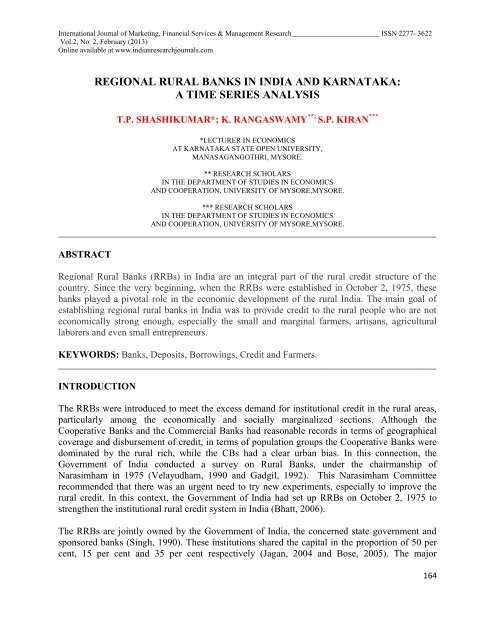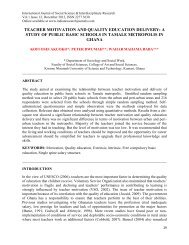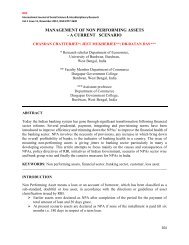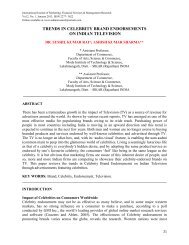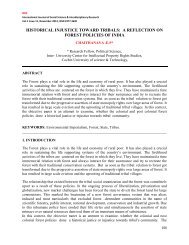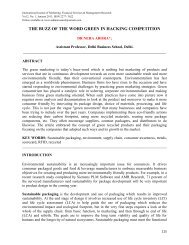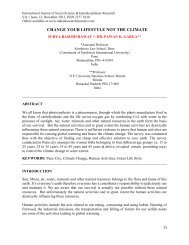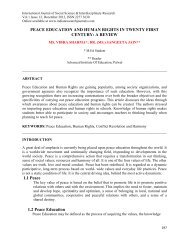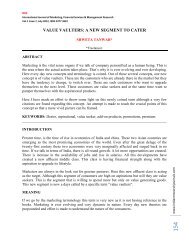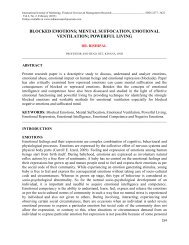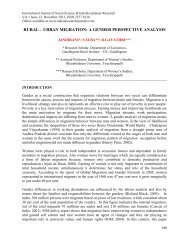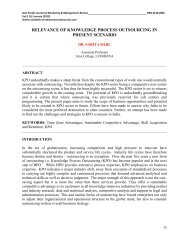regional rural banks in india and karnataka: a time series analysis
regional rural banks in india and karnataka: a time series analysis
regional rural banks in india and karnataka: a time series analysis
You also want an ePaper? Increase the reach of your titles
YUMPU automatically turns print PDFs into web optimized ePapers that Google loves.
International Journal of Market<strong>in</strong>g, F<strong>in</strong>ancial Services & Management Research________________________ ISSN 2277- 3622<br />
Vol.2, No. 2, February (2013)<br />
Onl<strong>in</strong>e available at www.<strong>in</strong>dianresearchjournals.com<br />
REGIONAL RURAL BANKS IN INDIA AND KARNATAKA:<br />
A TIME SERIES ANALYSIS<br />
T.P. SHASHIKUMAR*; K. RANGASWAMY **; S.P. KIRAN ***<br />
*LECTURER IN ECONOMICS<br />
AT KARNATAKA STATE OPEN UNIVERSITY,<br />
MANASAGANGOTHRI, MYSORE.<br />
** RESEARCH SCHOLARS<br />
IN THE DEPARTMENT OF STUDIES IN ECONOMICS<br />
AND COOPERATION, UNIVERSITY OF MYSORE,MYSORE.<br />
*** RESEARCH SCHOLARS<br />
IN THE DEPARTMENT OF STUDIES IN ECONOMICS<br />
AND COOPERATION, UNIVERSITY OF MYSORE,MYSORE.<br />
_____________________________________________________________________________________<br />
ABSTRACT<br />
Regional Rural Banks (RRBs) <strong>in</strong> India are an <strong>in</strong>tegral part of the <strong>rural</strong> credit structure of the<br />
country. S<strong>in</strong>ce the very beg<strong>in</strong>n<strong>in</strong>g, when the RRBs were established <strong>in</strong> October 2, 1975, these<br />
<strong>banks</strong> played a pivotal role <strong>in</strong> the economic development of the <strong>rural</strong> India. The ma<strong>in</strong> goal of<br />
establish<strong>in</strong>g <strong>regional</strong> <strong>rural</strong> <strong>banks</strong> <strong>in</strong> India was to provide credit to the <strong>rural</strong> people who are not<br />
economically strong enough, especially the small <strong>and</strong> marg<strong>in</strong>al farmers, artisans, agricultural<br />
laborers <strong>and</strong> even small entrepreneurs.<br />
KEYWORDS: Banks, Deposits, Borrow<strong>in</strong>gs, Credit <strong>and</strong> Farmers.<br />
_____________________________________________________________________________________<br />
INTRODUCTION<br />
The RRBs were <strong>in</strong>troduced to meet the excess dem<strong>and</strong> for <strong>in</strong>stitutional credit <strong>in</strong> the <strong>rural</strong> areas,<br />
particularly among the economically <strong>and</strong> socially marg<strong>in</strong>alized sections. Although the<br />
Cooperative Banks <strong>and</strong> the Commercial Banks had reasonable records <strong>in</strong> terms of geographical<br />
coverage <strong>and</strong> disbursement of credit, <strong>in</strong> terms of population groups the Cooperative Banks were<br />
dom<strong>in</strong>ated by the <strong>rural</strong> rich, while the CBs had a clear urban bias. In this connection, the<br />
Government of India conducted a survey on Rural Banks, under the chairmanship of<br />
Narasimham <strong>in</strong> 1975 (Velayudham, 1990 <strong>and</strong> Gadgil, 1992). This Narasimham Committee<br />
recommended that there was an urgent need to try new experiments, especially to improve the<br />
<strong>rural</strong> credit. In this context, the Government of India had set up RRBs on October 2, 1975 to<br />
strengthen the <strong>in</strong>stitutional <strong>rural</strong> credit system <strong>in</strong> India (Bhatt, 2006).<br />
The RRBs are jo<strong>in</strong>tly owned by the Government of India, the concerned state government <strong>and</strong><br />
sponsored <strong>banks</strong> (S<strong>in</strong>gh, 1990). These <strong>in</strong>stitutions shared the capital <strong>in</strong> the proportion of 50 per<br />
cent, 15 per cent <strong>and</strong> 35 per cent respectively (Jagan, 2004 <strong>and</strong> Bose, 2005). The major<br />
164
International Journal of Market<strong>in</strong>g, F<strong>in</strong>ancial Services & Management Research________________________ ISSN 2277- 3622<br />
Vol.2, No. 2, February (2013)<br />
Onl<strong>in</strong>e available at www.<strong>in</strong>dianresearchjournals.com<br />
objectives of the RRBs are; to develop the <strong>rural</strong> economy by provid<strong>in</strong>g credit facilities for<br />
agriculture, trade, commerce, <strong>in</strong>dustries <strong>and</strong> other productive activities <strong>in</strong> <strong>rural</strong> areas, particularly<br />
to the small <strong>and</strong> marg<strong>in</strong>al farmers. Further, the RRBs were <strong>in</strong>strumental <strong>in</strong> extend<strong>in</strong>g credit for<br />
poverty alleviation schemes. And also it is felt that the RRBs are <strong>in</strong>strumental <strong>in</strong> recogniz<strong>in</strong>g the<br />
diversified economic activities <strong>in</strong> the <strong>rural</strong> areas.<br />
The RRBs are the third important f<strong>in</strong>ancial <strong>in</strong>stitutions <strong>in</strong> the Indian Bank<strong>in</strong>g system. Table –1<br />
clearly <strong>in</strong>dicates that the performance of the RRBs from the liberalization period i.e., 1990-91 to<br />
2008-09. The table highlights that there is a consistency <strong>in</strong> terms of numbers dur<strong>in</strong>g first part<br />
compared to the second part. In addition to this most of the RRBs were amalgamation (comb<strong>in</strong>e<br />
together) dur<strong>in</strong>g the post liberalization regime compare to the liberalization regime. Because of<br />
the downsiz<strong>in</strong>g process of the public sector organizations, the GOI <strong>in</strong> consultation with sponsor<br />
<strong>banks</strong> <strong>and</strong> the National Bank for Agriculture <strong>and</strong> Rural Development (NABARD) took a<br />
decision to amalgamate the RRBs (Kumara Rama, 2008). The process of amalgamation resulted<br />
<strong>in</strong>to reduction <strong>in</strong> number of RRBs from 196 RRBs to 86 RRBs <strong>in</strong> March 2010. Currently around<br />
86 RRBs <strong>and</strong> 15,235 branches are work<strong>in</strong>g <strong>in</strong> 518 districts across the country (Sharma, 2009).<br />
The Table –1 clearly reveals the performance of the RRBs dur<strong>in</strong>g the liberalisation period from<br />
1990-91 to 2008-09. However, the performance is far better dur<strong>in</strong>g the first part of liberalisation<br />
period compared to the second part i.e., 2000-01 to 2008-09. This is ma<strong>in</strong>ly because, most of the<br />
RRBs, were amalgamated dur<strong>in</strong>g the post liberalisation regime compared to the liberalisation<br />
regime. The GOI <strong>in</strong> consultation with sponsor <strong>banks</strong> <strong>and</strong> the NABARD took a decision to<br />
amalgamate the RRBs ma<strong>in</strong>ly to downsize the public sector organizations. The process of<br />
amalgamation resulted <strong>in</strong> the reduction of the number of RRBs from 196 to just 86 RRBs <strong>in</strong><br />
March 2010. Currently there are only around 86 RRBs <strong>and</strong> 15,235 branches work<strong>in</strong>g <strong>in</strong> 518<br />
districts across the country. The overall CGRs clearly <strong>in</strong>dicate that the growth rates are positive<br />
for all the variables.<br />
165
International Journal of Market<strong>in</strong>g, F<strong>in</strong>ancial Services & Management Research________________________ ISSN 2277- 3622<br />
Vol.2, No. 2, February (2013)<br />
Onl<strong>in</strong>e available at www.<strong>in</strong>dianresearchjournals.com<br />
Table-1: Performance of the RRBs <strong>in</strong> India Over a Period of Time.<br />
Years No.of No.of Deposits Borrow<strong>in</strong>gs Investments Loans &<br />
RRBs Branches ( <strong>in</strong> ( <strong>in</strong> ( <strong>in</strong> Advances<br />
Crore) Crore) Crore) ( <strong>in</strong> Crore)<br />
1990-91 196 14443 4151 1184 2981 1938<br />
1991-92 196 14527 6748 1615 4856 1977<br />
1992-93 196 14539 17808 4522 13201 6572<br />
1993-94 196 14543 22488 5201 17074 8400<br />
1994-95 196 14542 25726 5612 19646 10549<br />
1995-96 196 14509 29958 6189 23038 13878<br />
1996-97 196 14497 35298 6771 25968 17170<br />
1997-98 196 14461 43288 7334 28743 20952<br />
1998-99 196 14475 54338 7992 31490 23986<br />
1999-2000 196 14499 67226 8788 36609 27488<br />
CGR 0.00 -0.02 20.00 10.00 15.00 23.00<br />
2000-01 196 14301 81476 9839 45363 32007<br />
2001-02 196 14311 97579 10638 56780 38036<br />
2002-03 196 14350 115059 11921 72409 46106<br />
2003-04 196 14311 132931 13080 86515 55837<br />
2004-05 196 14446 150988 13919 99731 66901<br />
2005-06 196 14484 168591 14918 105966 81142<br />
2006-07 133* 14494 189822 17422 114086 98696<br />
2007-08 96* 14521 216620 22603 123616 118075<br />
2008-09 91* 14761 253571 28572 135515 143798<br />
2009-10 86* 15235 296559 33520 145491 169926<br />
CGR -10.07 0.50 15.00 14.00 13.00 21.00<br />
OCGR -3.29 0.07 18.00 11.00 16.00 20.00<br />
Notes: OCGR = Overall Compound Growth Rate<br />
* <strong>in</strong>dicates that <strong>in</strong> the respective years so many RRBs were amalgamated.<br />
Sources: Various Reports of NABARD <strong>and</strong> RBI.<br />
166
International Journal of Market<strong>in</strong>g, F<strong>in</strong>ancial Services & Management Research________________________ ISSN 2277- 3622<br />
Vol.2, No. 2, February (2013)<br />
Onl<strong>in</strong>e available at www.<strong>in</strong>dianresearchjournals.com<br />
Progress of the Regional Rural Banks <strong>in</strong> Karnataka:<br />
Agriculture <strong>and</strong> <strong>rural</strong> sector play an important role <strong>in</strong> India’s overall development. Regional<br />
Rural Banks (RRBs) were formed through RBI Act of 1976 to provide the credit to the <strong>rural</strong><br />
poor. RRBs were expected to evolve as specialized <strong>rural</strong> f<strong>in</strong>ancial <strong>in</strong>stitutions for develop<strong>in</strong>g the<br />
<strong>rural</strong> economy by provid<strong>in</strong>g credit to small <strong>and</strong> marg<strong>in</strong>al farmers, agricultural labourers, artisans<br />
<strong>and</strong> small entrepreneurs (Sardesai Committee, 2005). Dhananjaya (2005) <strong>in</strong> his paper stated that<br />
RRBs have played a key role <strong>in</strong> India <strong>in</strong> enhanc<strong>in</strong>g f<strong>in</strong>ancial services <strong>in</strong> <strong>rural</strong> areas. Apart from<br />
their focus on lend<strong>in</strong>g to the priority sector, these <strong>banks</strong> have also evolved different sav<strong>in</strong>gs<br />
products to provide safe sav<strong>in</strong>gs options <strong>in</strong> the <strong>rural</strong> areas. Over the years, RRBs emerged as a<br />
key <strong>rural</strong> f<strong>in</strong>ancial <strong>in</strong>stitutions <strong>in</strong> terms of geographical coverage, clientele outreach <strong>and</strong> bus<strong>in</strong>ess<br />
volume. From a modest beg<strong>in</strong>n<strong>in</strong>g of six RRBs with 17 branches cover<strong>in</strong>g 12 districts <strong>in</strong><br />
December 1975, the number of RRBs has grown <strong>in</strong>to 196 with 14,446 branches work<strong>in</strong>g <strong>in</strong> 518<br />
districts across the country <strong>in</strong> March 2004 (just before the amalgamation process). As on March<br />
2009, RRBs have a large branch network <strong>in</strong> the <strong>rural</strong> area form<strong>in</strong>g around 37 per cent of the total<br />
<strong>rural</strong> branches of Commercial Banks. The <strong>rural</strong> orientation of RRBs is evident from the fact that<br />
their <strong>rural</strong> <strong>and</strong> semi-urban branches constituted over 95 per cent of their branch network.<br />
Table-2 presents the performance of the RRBs <strong>in</strong> Karnataka State from the liberalization period<br />
i.e., 1990-91 to 2009-10. RRBs <strong>in</strong> Karnataka have achieved significant growth <strong>in</strong> terms of<br />
number of wide branches dur<strong>in</strong>g the both regimes. S<strong>in</strong>ce 1990-91 there were 13 RRBs with 1075<br />
branches work<strong>in</strong>g across the districts of Karnataka state. In addition to these compound growth<br />
rates were worked out to underst<strong>and</strong> the progress of the RRBs <strong>in</strong> Karnataka State, the highest<br />
growth rate could be observed <strong>in</strong> case of deposits constitut<strong>in</strong>g about 22.92 per cent compared to<br />
the Advances of the RRBs dur<strong>in</strong>g the liberalization regime. Dur<strong>in</strong>g the post liberalization regime<br />
the highest growth can be searched <strong>in</strong> case of Advances constitut<strong>in</strong>g about 20.29 per cent<br />
compared to the deposits. When the growth rate is observed it is the <strong>in</strong>crease of RRBs<br />
constitut<strong>in</strong>g about 20.39 per cent compared to the advances. In this manner s<strong>in</strong>ce from their<br />
<strong>in</strong>ception the RRBs have rendered services to the <strong>rural</strong> people <strong>and</strong> play an important role along<br />
with other f<strong>in</strong>ancial <strong>in</strong>stitutions.<br />
167
International Journal of Market<strong>in</strong>g, F<strong>in</strong>ancial Services & Management Research________________________ ISSN 2277- 3622<br />
Vol.2, No. 2, February (2013)<br />
Onl<strong>in</strong>e available at www.<strong>in</strong>dianresearchjournals.com<br />
Table-2: Performance of the RRBs <strong>in</strong> Karnataka State Over a Period of Time<br />
Years No.of Branches Deposits<br />
Advances<br />
( <strong>in</strong> Crore) ( <strong>in</strong> Crore)<br />
1990-91 1075 316 376<br />
1991-92 1075 380 384<br />
1992-93 1075 460 432<br />
1993-94 1075 584 546<br />
1994-95 1074 768 721<br />
1995-96 1074 964 892<br />
1996-97 1074 1118 1052<br />
1997-98 1073 1325 1210<br />
1998-99 1075 1592 1365<br />
1999-2000 1085 1990 1639<br />
CGR 0.04 22.92 19.55<br />
2000-01 1096 2432 1979<br />
2001-02 1103 2720 2256<br />
2002-03 1107 3264 2594<br />
2003-04 1120 4134 3650<br />
2004-05 1124 4569 4177<br />
2005-06 1127 5004 4705<br />
2006-07 1128 6025 5893<br />
2007-08 1153 7618 7082<br />
2009-10 1184 9981 8788<br />
2010-11 1201 11727 9781<br />
CGR 0.94 19.01 20.29<br />
OCGR 0.52 20.39 19.48<br />
Source: NABARD Annual Reports.<br />
Tungabhadra Grameena Bank (GB) was the first RRB to be established <strong>in</strong> Karnataka state. It had<br />
started function<strong>in</strong>g on January 27, 1976 with its head office at Bellary. Two more RRBs i.e.,<br />
Malaprabha GB <strong>and</strong> Cauvery GB also started their operations <strong>in</strong> the same year. As on March<br />
168
International Journal of Market<strong>in</strong>g, F<strong>in</strong>ancial Services & Management Research________________________ ISSN 2277- 3622<br />
Vol.2, No. 2, February (2013)<br />
Onl<strong>in</strong>e available at www.<strong>in</strong>dianresearchjournals.com<br />
2005, there were 13 RRBs with 1124 branches operat<strong>in</strong>g <strong>in</strong> the 27 districts of Karnataka State<br />
(Table-3). Subsequent to the amalgamation process number of RRBs reduced to six while<br />
leav<strong>in</strong>g the number of branches almost <strong>in</strong>tact. Because of the downsiz<strong>in</strong>g process of the public<br />
sector organizations, the GOI <strong>in</strong> consultation with sponsor <strong>banks</strong> <strong>and</strong> the NABARD took a<br />
decision to amalgamate the RRBs. As on March 2010, there were 6 RRBs with 1184 branches<br />
work<strong>in</strong>g <strong>in</strong> 30 districts across the Karnataka State (Table-4).<br />
Table-3: Status of the RRBs <strong>in</strong> Karnataka on March 27, 1985.<br />
Name of the Banks Date of Establishment Districts Covered<br />
1 Tungabhadra Grameena Bank 20/01/1976 Raichur- Bellary<br />
2 Malaprabha Grameena Bank 16/08/1976 Dharwad- Belgum<br />
3 Cauvery Grameena Bank 2/10/1976 Mysore- Hassan<br />
4 Krishna Grameena Bank 1/12/1978 Bidar<br />
5 Chitradurga Grameena Bank 5/8/1981 Chitradurga- Tumkur<br />
6 Kalpatharu Grameena Bank 31/03/1982 Bangalore (Rural)<br />
7 Kolar Grameena Bank 16/02/1983 Kolar<br />
8 Bijapur Grameena Bank 31/03/1983 Bijapur<br />
9 Chikkamagaluru-Grameena Bank 28/04/1984 Chikkamagaluru- Coorg<br />
10 Sahayadri Grameena Bank 6/9/1984 Shimoga<br />
11 Netravathi Grameena Bank 11/10/1984 South Kanara<br />
12 Vardha Grameena Bank 12/10/1984 North Kanara<br />
13 Vishveshwaraiah Grameena Bank 27-03-1985 M<strong>and</strong>ya<br />
Sources: State Focus paper, Karnataka <strong>and</strong> NABARD Annual Reports.<br />
169
International Journal of Market<strong>in</strong>g, F<strong>in</strong>ancial Services & Management Research________________________ ISSN 2277- 3622<br />
Vol.2, No. 2, February (2013)<br />
Onl<strong>in</strong>e available at www.<strong>in</strong>dianresearchjournals.com<br />
Table-4: Status of the Regional Rural Banks <strong>in</strong> Karnataka as on May 24 th 2006.<br />
Sponsor Date of Number of<br />
Banks Establishment Districts Covered<br />
1<br />
.<br />
2<br />
.<br />
3<br />
.<br />
4<br />
.<br />
5<br />
.<br />
6<br />
.<br />
Name of the<br />
Banks<br />
Krishna<br />
Grameena Bank<br />
Chikkamangalur<br />
<strong>and</strong> Kodagu<br />
Grameena Bank<br />
Vishveswaraiah<br />
Grameena Bank<br />
Karnataka Vikas<br />
Garameena<br />
Bank<br />
Pragathi<br />
Grameena Bank<br />
Cauvery<br />
Kalpatharu<br />
Grameena Bank<br />
State Bank of<br />
India<br />
Corporation<br />
Bank<br />
Number of<br />
Branches<br />
1-Dec-1978 2 109<br />
28-Apr-1984 2 47<br />
Vijaya Bank 27-Mar-1985 1 27<br />
Syndicate<br />
Bank<br />
*12-Sep-2005 9 407<br />
Canara Bank *12-Sep-2005 7 360<br />
State Bank of<br />
Mysore<br />
*24-May-2006 8 203<br />
Note: * Date of Amalgamation<br />
Sources: State Focus paper, Karnataka <strong>and</strong> NABARD Annual Reports.<br />
CONCLUSION:<br />
Indian bank<strong>in</strong>g has come a long way s<strong>in</strong>ce from the British period. S<strong>in</strong>ce then the public sector<br />
<strong>banks</strong> cont<strong>in</strong>ued to play a very prom<strong>in</strong>ent role <strong>in</strong> both deposit mobilization <strong>and</strong> credit<br />
disbursement even dur<strong>in</strong>g the privatisation era. They contribute about 75 per cent of the total<br />
deposits mobilised <strong>and</strong> total loans advanced by all the scheduled CBs. Though there are so many<br />
private <strong>banks</strong> who have been compet<strong>in</strong>g with the public sector <strong>banks</strong>, as we know whatever the<br />
better facilities provided by the private <strong>banks</strong>, one way or the other, the exploitation is more.<br />
Hence, we need to <strong>in</strong>ject new policies <strong>and</strong> programmes to stabilize the exist<strong>in</strong>g public bank<strong>in</strong>g to<br />
achieve the maximum social welfare<br />
170
International Journal of Market<strong>in</strong>g, F<strong>in</strong>ancial Services & Management Research________________________ ISSN 2277- 3622<br />
Vol.2, No. 2, February (2013)<br />
Onl<strong>in</strong>e available at www.<strong>in</strong>dianresearchjournals.com<br />
REFERENCES:<br />
Bhatt Nit<strong>in</strong> <strong>and</strong> Y. S. P. Thorat (2006). India’s Regional Rural Banks: The Institutional<br />
Dimension of Reforms. Journal of Microf<strong>in</strong>ance, 3 (1), pp: 65-94.<br />
Bose Sukanya (2005). Regional Rural Banks: The Past <strong>and</strong> the Present Debate. Macro Scan,<br />
URL: http://www.macroscan.com/fet/jul05/ fet200705RRB_Debate.htm.<br />
Gadgil M.V. (1992). Future of Institutional Agricultural Credit <strong>in</strong> India: Likely Impact of<br />
Narasimham <strong>and</strong> Khusro Committee Reports. Indian Journal of Agricultural Economics, 47 (2),<br />
pp: 255-65.<br />
Kumar Rama <strong>and</strong> Pallavi Chavan (2008). Revival of Agricultural Credit <strong>in</strong> the 2000s: An<br />
Explanation. Economic <strong>and</strong> Political Weekly, XLII (52), pp: 57-60.<br />
Mohan Jagan (2004): “Regional Rural Banks Need a Shot <strong>in</strong> the Arm”, F<strong>in</strong>ancial Daily from the<br />
H<strong>in</strong>du Group of Publications. March 19th Edition.<br />
NABARD, Annual Report, Various Issues.<br />
RBI, Annual Report <strong>and</strong> Report on Trends <strong>and</strong> Progress of Bank<strong>in</strong>g <strong>in</strong> India, Various Issues.<br />
Sharma A.K. <strong>and</strong> Asha Upwanshi Wasewar (2009). Agriculture Credit: Organisation, Problems<br />
<strong>and</strong> Challenges <strong>in</strong> Inida. Asian Economic Review, 51 (2), pp: 291-310.<br />
Sahu Gagan Bihari (2007). Supply Analysis of Institution Credit to Agriculture for Major States<br />
<strong>in</strong> India. Indian Journal of Agricultural Economics, 62(4), pp: 664-70.<br />
S<strong>in</strong>gh Surjeet (1990). Rural Credit: Issues for the N<strong>in</strong>eties. Economic <strong>and</strong> Political Weekly, 25<br />
(46), pp: 2531-535.<br />
Velayudham, T. K. <strong>and</strong> V. Sankaranarayanan (1990). Regional Rural Banks <strong>and</strong> Rural Credit:<br />
Some Issues. Economic <strong>and</strong> Political Weekly. 25(38), pp: 2157-2161.<br />
171
International Journal of Market<strong>in</strong>g, F<strong>in</strong>ancial Services & Management Research________________________ ISSN 2277- 3622<br />
Vol.2, No. 2, February (2013)<br />
Onl<strong>in</strong>e available at www.<strong>in</strong>dianresearchjournals.com<br />
******************<br />
172


